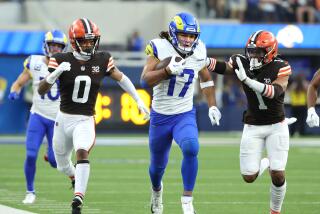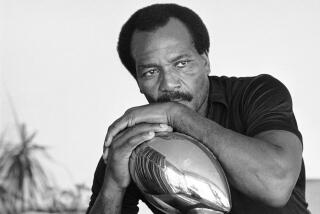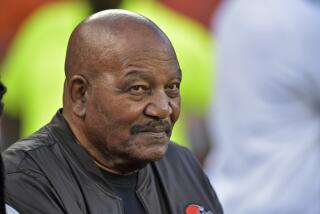Speedie Turns a Home Into a Hall : Pro football: Former Cleveland Browns’ great says he’s no longer bitter about not making it to NFL’s Hall of Fame.
- Share via
LAGUNA HILLS — Mac Speedie, former Cleveland Brown receiver, conducted the tour personally. He examined each photo and trophy, pointing out the significant ones.
“ . . . there’s the original ’46 Browns . . . “
” . . . there’s Lou Saban and Otto Graham and a bunch of the guys . . . “
” . . . there’s the ball from the Philadelphia game. I must have done OK that day. Probably caught a bunch of passes and scored some touchdowns. Stuff like that . . . “
This is Mac Speedie’s Hall of Fame, far from the one in Canton, Ohio. Here, the Cleveland Browns, circa 1946-52, live on the walls and shelves of the Laguna Hills home, which Speedie says he rarely leaves.
It was a team of Otto Graham, Lou Groza, Dante Lavelli, Marion Motley. And Mac Speedie. The first four are enshrined in Canton. Speedie is not.
He is a victim, he and others say, of General Manager-Coach Paul Brown, who never forgave or forgot that Speedie jumped to the Canadian Football League after the 1952 season.
“I was overlooked and a lot of it was Paul Brown,” said Speedie, 71. “He told me when I jumped leagues that he was going to get even with me. There was a time when it bothered me, but that was years and years ago. It really isn’t important anymore.”
Speedie was a big part of the Cleveland dynasty. Brown’s Browns dominated the All-American Football Conference, then joined the NFL in 1950 and won the title that year.
Speedie caught 349 passes for 5,584 yards and 33 touchdowns. He led the AAFC in receiving three times and the NFL once.
Yet, the Hall of Fame has eluded his grasp.
“Who needs the Hall of Fame?” Speedie said. “I have my own. I have a lot of great memories.”
In all, seven members from that Browns’ era are in the Hall of Fame. Speedie was considered as good as any of them, even Lavelli, Cleveland’s other receiver.
“Mac was faster and smoother,” Graham said. “He was almost impossible to cover one on one. Dante worked harder and probably had better hands. I tell you, without those two, I never would have made the Hall of Fame.”
Speedie was an honorable mention All-American at Utah in 1942, then joined the Army. He was playing for the Fort Warren (Wyo.) team in 1946 when Brown discovered him.
Brown’s Great Lakes team played Fort Warren. Several months later, when Brown became coach and general manager of the Cleveland Browns, he signed Speedie for $7,000. It proved to be a good investment.
Speedie led the AAFC in receiving from 1947-49.
“I would always watch Mac pick up things,” Lavelli said. “He was tall and slender and really fast. He also had great moves. He could really fake out defensive backs.”
After winning four AAFC championships, the Browns beat the Rams, 30-28, in the 1950 title game.
Speedie caught 42 passes that season and 34 in 1951. The following year, he had 62 receptions to lead the league, finishing ahead of Tom Fears, Elroy Hirsch and Lavelli.
Speedie was named the Browns’ most valuable player--and never played for them again. In 1953, he joined Saskatchewan of the CFL.
“The main reason I left for Canada was M-O-N-E-Y,” Speedie said. “At $15,000, I was the highest paid receiver in the NFL. But I got quite a bit more to go to Canada.”
But money wasn’t the only reason. There was also Paul Brown.
At 33, Speedie was one of the older players on the team. He said that, sooner or later, he would be replaced by Brown.
And it would likely be sooner.
“Brown never liked older football players,” Speedie said. “I think he was just waiting for the time when he could say, ‘I don’t need you anymore.’ After seven years, I’d had enough.”
Speedie and Brown had little in common. Brown was very straight-laced, especially when it came to drinking. And Speedie . . . well, he wasn’t.
“Mac wasn’t a Bobby Layne, but he also wasn’t an Otto Graham,” said Graham, a notorious teetotaler. “He was a happy-go-lucky type of guy and he had a lot of fun.”
Said Speedie: “We’d go drinking after games and practice, but not when Brown was around.”
Speedie said there were others on the team who didn’t care for Brown’s tactics. But winning kept the lid on the situation.
Besides the four AAFC titles, the Browns played in six NFL title games, winning three, between 1950-55.
Off the field, things weren’t quite as smooth. There were confrontations even in winning, according to Speedie.
“One year, after we had won the championship, we were meeting to divide playoff shares,” he said. “Brown walks in and said, ‘Gentlemen, I want you to know I’m not eligible for a share because I’m part-owner of the team. However, the assistant coaches are not part-owners, so I want you to vote all of them a full share or I will pay for it out of my own pocket.
“The vote was 33-3 . . . No.”
The conflict between Speedie and Brown became a personal one. One year, Speedie brought a pet skunk to camp. He named it Paul.
“The guys on the team couldn’t wait to tell him about it,” Speedie said. “He approached me and said, ‘I don’t think that was very funny. I said, ‘You got it wrong. This is a night animal. I named him after Paul Revere.’ I also said, ‘If you believe that, you also believe in the tooth fairy.’ ”
The following year, Speedie went to Canada.
After three seasons in the CFL--two of which he was named All-Canada--Speedie retired.
He returned to football as an assistant coach of the Houston Oilers in the American Football League in 1960. In 1962, he joined the Denver Broncos as an assistant, then became the club’s head coach and general manager in 1964.
Speedie coached a little more than two years, compiling a 6-19-1 record before resigning in 1966. He remained in the organization as a scout until retiring in 1982.
One by one Speedie’s Cleveland Brown teammates were inducted into the Hall of Fame. Lavelli, who caught 386 passes during his career, was elected in 1975. He thought Speedie would soon follow.
“I’ve written letters for years, saying that Mac should be in the Hall of Fame,” Lavelli said. “I can’t understand it.”
Others can, however.
“Quite honestly, I think Paul Brown is the reason,” Graham said. “Paul wasn’t the type of guy you crossed. He would never forget it.”
Speedie talked with Brown only once after leaving Cleveland. It was at the East-West Shrine game in 1977.
Said Speedie: “I went up to him and said, ‘Hi Paul, I’m Mac Speedie. He said, ‘Yes, I know. You’re the one who went to Canada.’ Twenty five years later and he still hadn’t forgiven me.”
There are no photos of Brown on the wall in Speedie’s home. There are other things he’d rather remember.
“ . . . that ball was from a game we played in a terrible rain storm. We completed only two passes that night, both for touchdowns. I caught them both and we won, 14-0 . . . “
Speedie’s Career
All-American Football Conference
Year Rec. Yards TDs 1946 24 546 7 1947 67 1,146 6 1948 58 816 4 1949 62 1,028 7
National Football League
Year Rec. Yards TDs 1950 42 548 1 1951 34 589 3 1952 62 611 5 Totals 349 5,584 33
More to Read
Go beyond the scoreboard
Get the latest on L.A.'s teams in the daily Sports Report newsletter.
You may occasionally receive promotional content from the Los Angeles Times.











